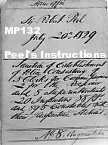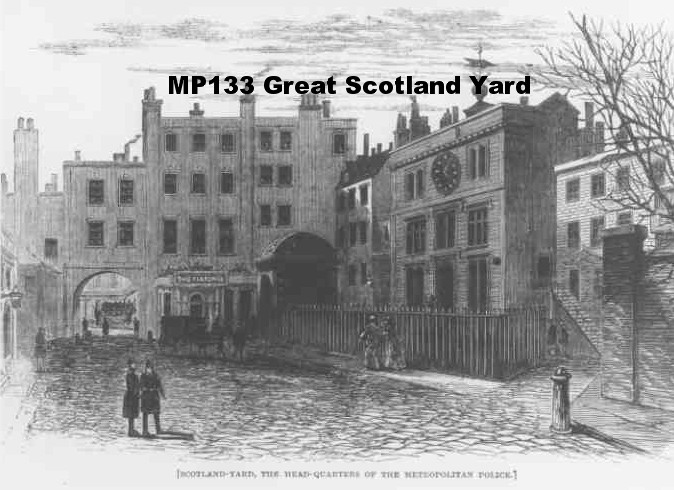Back Home Commissioners Organisation Recruitment and Discipline Public Reaction
The formation of the Metropolitan Police - in 1829
The Metropolitan Police Act came into force on 19th June 1829 after Home Secretary Sir Robert Peel had eventually persuaded Parliament of the importance of a new police force for London so that rampant crime and disorder could be controlled. The City of London was excluded, partly because they already had an early form of organised uniform patrol.
The Receiver
John Wray was appointed as Receiver for the Metropolitan Police District on 7th July 1829. It was his job to collect all the money from local parishes to fund the new force. He was a barrister, and also ran the University Life Assurance Society. His salary was £700 pa and he eventually served until 1860, when he retired, aged 78 years. He had provided a personal bond of £9,000 when he started the job, but the Home Office could not find it when he came to retire! Although completely honest, he was apparently far from organised by today's standards. Most communication was verbal, and Wray's interest in the accuracy of account keeping was remote. By the time he retired, the strength of the Metropolitan Police had reached 10,000. The legal status was that of a 'corporation sole', which although old-fashioned, had the merits of personal accountability and lack of bureaucracy which some would envy nowadays.
John Wray
There were two Commissioners, following the practice of the River Thames Marine Police (founded 1798) who had two joint Commissioners. They started work on 7th July 1829. The first was Colonel (Sir) Charles Rowan who had served in the Peninsular War. Rowan had seen small patrols criss-crossing territory during that war, and it was this idea which led to the introduction of the beat system. He had also embraced the new idea that the quality of military discipline should not be judged by the number of floggings in a regiment's discipline records, but by the absence of harsh disciplinary action. This then developed into the doctrine that it was the absence of crime which should be the mark of an efficient police force. He was older than his partner Mayne, and tended to be regarded as the "Chief Commissioner", but history would never regard Mayne's contribution as being less than Rowan's.
Sir Charles Rowan
The other Commissioner was (Sir) Richard Mayne who became the longest serving Commissioner in history. He died in 1868, aged 72 years, whilst still serving as Commissioner. He was a barrister and provided the early instructions to the new police about the law and their powers as Constables. His brother became the Chief Constable of Shropshire. After Rowan retired, a successor was appointed, but it was not long before Mayne became sole Commissioner.
The salary of both Commissioners was set at £800 pa.

Sir Richard Mayne
Sir Robert Peel set out the structure and the salaries of the force in a written memorandum dated 20th July:

The new headquarters was established at 4 Whitehall Place, and the back entrance, used by visitors to the Commissioners, was in Scotland Yard. This eventually led to the headquarters name of Scotland Yard.

The new force took over some of the old watch houses, but also acquired new premises which were called "stations", "guardhouses" or "depots".
Initially there were eight Divisions, staffed by "companies", each with a designated letter of the alphabet, and with a Superintendent in charge. These were later extended as the force expanded:
| A - Whitehall | H - Whitechapel | R - Greenwich |
| B - Chelsea | J - Bethnal Green | S - Hampstead |
| C - St James's | K - Bow | T - Hammersmith |
| D - Marylebone | L - Lambeth | V - Wandsworth |
| E - Holborn | M - Southwark | W - Clapham |
| F - Covent Garden | N - Islington | X - Kilburn |
| G - Finsbury | P - Camberwell | Y - Highgate |
For a map of the early Metropolitan Police District, click here.
The letters seen on officers' epaulettes today had their origins in this system, and in many cases the first letter of the modern Divisional or Borough code relates to the same area as in 1829.
The first recruits reported for training on 21st September, were allocated to Divisions and fitted with uniforms of top hat and tail coat. The authorities decided to make the uniform civilian rather than military in appearance. The uniforms were blue rather than the military red, and this earned the force the nickname of "Peel's raw lobsters" comparing the colour to the military uniforms which were already known as "lobsters".
PC Richard Clark wearing the uniform jacket current from 1829 - 1864
In the first few days many officers were dismissed, either for non-appearance or for drunkenness. Later, when a register (preserved in the National Archives) was set up with warrant numbers, the first 466 numbers were allocated to those who had been dismissed. Of the first 3,247 men recruited in the first six months, no fewer than 1644 (51%) were dismissed, the most common cause being for drunkenness. 149 of these were later re-instated. A system for less serious sanctions such as suspensions, reprimands and fines had apparently not been developed at this stage. 148 resignations were later followed by re-employment, sometimes because the officer had to resign and then re-join if he became ill. For a list of the recruits in the first six months, click here.
780 men had left the Force in the first six months, and this rapid turnover caused Mr Charles Hebbert, the first clothing contractor, to complain to the Receiver about the extra cost involved in altering and re-issuing so many uniforms!
The first officers went out on patrol on the streets of London on the evening of Friday 25th September 1829. It was not until later that regular patrols during the day were started.
There was resistance to the new system from those who regarded an organised uniform police force as a threat to their civil liberties. The congregation at the first Sunday morning service in October 1829 at St Anne's church, Soho heard a notice between prayers and the sermon that their parish contribution had been set at £1,236. 4s 8d. This "..prevented any thing like religious feelings to pervade for the rest of the service" according to the Morning Herald.
Juries at the inquests of two of the first officers killed on duty, PC Joseph Grantham and PC Robert Culley, returned verdicts of justifiable homicide. PC Culley had been stabbed to death at a demonstration in Cold Bath Fields, Clerkenwell in May 1833, and the jury became public celebrities because of their decision. Within days, the plight of PC Culley's widow began to turn the tide of opinion, however, and the police began to win public confidence, partly as the result of the restraint, courage and forbearance shown by those early officers 175 years ago.
Back to top Stories Home Encyclopedia Contact Us